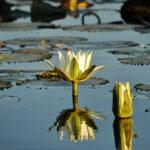Tsodilo Hills
10 sq. km
1927 (National Monument) | 2001 (UNESCO WHS)
May to August
Ancient rock art paintings
Tsodilo Hills has periodically provided shelter for humans for over 100,000 years. It consists of four quartzite rock hills, the highest reaching 410 metres from the ground (and 1 400 metres above sea level). The main attraction are the more than 4500 ancient rock art paintings.
Journey back in time
Marvel at the well-preserved, original rock paintings created by early humans at one of the oldest historical sites in the world. Through the art left by these early people, you are offered a unique look at the development of the human species and the interesting relationship they had with the nature around them.
Tsodilo Hills is a treasure trove for anyone wanting a better insight into early human life and the development thereof. Containing rock paintings which range from the Stone Age right up to the 19th Century, few places in the world contain such a high concentration of important rock art. The paintings cover a wider range of different geometric shapes, animal species and human figures, created over different periods of time. Some paintings have even been speculated to reflect penguins and whales, which would be a very uncommon sight in the Kalahari Desert! These paintings would suggest the ancient San (or Basarwa as they are sometimes referred to in Botswana) had knowledge of these creatures and they preserved their knowledge on these rocks through paintings for future generations to see. Fishhooks have also been discovered at Tsodilo Hills, these tracing back to approximately 20,000 years ago. So perhaps the paintings before mentioned do not actually depict penguins or whales but rather fish, which were once found in the area. You will have to come and judge for yourself.
You can find paintings of not only the San but also of the Bantu-speaking Hambukushu tribe at Tsodilo Hills. To differentiate the paintings from another, one needs to look at the colour of them. The oldest rock paintings are those of the San and are a red colour made from what is believed to be a mixture of blood and red ochre clay. The more recent Hambukushu’s paintings are white and are speculated to consist of a mixture containing ostrich shells and ash. The Tsodilo Hills are sacred to both peoples and they both believe it to be the home of their ancestral spirits. The site also contains the exact spot where the Hambukushu believe their god brought them and their cattle down to earth.
Along the historical path you might also encounter some of the area’s wildlife. The Tsodilo Hills are home to kudu, duiker and steenbok as well as many other smaller creatures. Sometimes you may even see leopard tracks as leopards do roam these hills, however sighting them is very rare indeed.
Through the help of a local guide, the Tsodilo Hills and its paintings can come alive as you discover more about this ancient site. Each step on a guided tour is a step towards a better understanding of an ancient way of life and each painting, a monument to a time long passed.
The Four Hills
You will find four hills, resting on the otherwise flat Kalahari plains. The hills are referred to as the “Male”, the “Female” and the “Child”. The fourth hill seen in the distance, remains unnamed. According to ancient legend, this hill is the first wife of the male hill, who left her for a younger hill.
A Sacred Place
You may explore this site, sacred to the local San, who consider Tsodilo Hills to be the resting place of their ancestral spirits. They believe that misfortune will befall onto those who hunt or kill near the hills.
Ancient Rock Art
You will visit one of the largest concentrations of rock art in the world. Tsodilo Hills holds over 350 different sites and in total, over 4 500 rock paintings.
WHEN TO GO
Best time to go to the Tsodilo Hills
The Tsodilo Hills can be visited at any time of year. During the winter, the temperatures are most pleasant. During the warmer summer months, it is recommended you explore the area in the morning or in the afternoon and have water and a sun hat with you as it may get hot.
Dry Season
May to AugustBest for cooler temperatures
Green Season
November to MarchBest to visit early in the morning
Why to go
Experience an impressive collection of ancient art
Sometimes referred to as the ”Louvre of the Desert” because of the sheer number of rock art on site, take your time to quietly reflect on the art and the environment around you when observing these ancient rock paintings.


I would definitely recommend a visit to Tsodilo Hills if you’re interested in the history and culture of Southern Africa. It’s an amazing ancient open-air art gallery and many of the paintings are very well preserved. If you visit during the summer, make sure to come early in the morning as it can get very hot.Luisa | Botswana Travel Expert
Location
The UNESCO World Heritage Site Tsodilo Hills is located in north-western Botswana, north-west of the Okavango Delta and overlooking the Kalahari. You can drive from the nearest town Shakawe or do a day trip from Nxamaseri Island Lodge in the Okavango Delta.
- Tsodilo Hills
- Mahango Game Park 100 km | 2-3 hours’ drive | 20 minutes’ flight
- Shakawe 80 km | 1-2 hours’ drive | 10 minutes’ flight
- Okavango Panhandle 50 km | 1 hours’ drive | 10 minutes’ flight
- Khaudum National Park 380 km | 8 hours’ drive
- Maun 390 km | 6 hours’ drive | 45 minutes’ flight
- Makgadikgadi Pans National Park 550 km | 9 hours’ drive



Experience Botswana with us
Speak to one of our local advisors
Let's start planning your trip!
We will get back to you within 2 working days.










